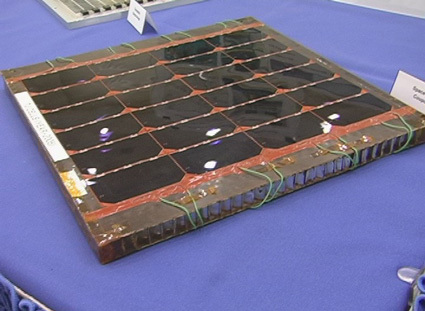Solar cells could power most of your home in the future
Sylmar (CA) - Almost all your electricity comes from a local power plant, usually of a coal, natural gas or nuclear variety, but in the future most of this electricity could come from high-efficiency solar cells. Spectrolab, a Boeing subsidiary, is currently producing cells that are almost 40% efficient and promise even higher efficiencies in the future. Company executives and engineers explained how the solar cells work and even gave us a tour of their Sylmar California factory.
Spectrolab currently earns most of its revenue from selling satellite-based solar cells and around 60% of satellites use a Spectrolab-based solar panel. Surprisingly, space-based solar cells are less efficient, percentage-wise, than terrestrial cells. The reason, according to Dr. Lillington, President of Spectrolab, is that the bluer sunlight in space is not absorbed as well.
Lillington added that a terrestrial solar cell would generally be about 10 percent more efficient than its space-based counterpart. Despite this efficiency gap, space cells still win out because satellites get 100% percent of the sun's energy, while our atmosphere filters out about one-fifth of the energy.
According to Dr. Lillington, Spectrolab is trying to cash in on the massive home market with concentrator-based gallium-arsenide cells that promise to be much more efficient than traditional silicon cells. These cells use relatively inexpensive mirrors and lenses to focus sunlight onto the expensive semiconductor portion of the solar cell.
Spectrolab has already developed a 40% efficient concentrator-based cell and thinks a 45% efficient cell can be made by 2009. Lillington said 45% is "probably the limit" of what can be produced with current technology and materials.
Click to start the video ...
During our factory tour, Jeff Peacock, Director of Photo Voltaic Products, told us that mirrors and lenses can concentrate light by as much as 500 times which allows a one centimeter square cell to produce 16 watts. He added that such a cell costs about $10 to $20 to make.
Get Tom's Hardware's best news and in-depth reviews, straight to your inbox.
Spectrolab produces approximate 700 kilowatts worth of non-concentrated gallium arsenide solar panels annually. Company representatives said more than 200 megawatts can be squeezed out of the same panels if concentrators are used.
Worldwide solar panel production is led by Japanese companies like Sharp and Kyocera, but American companies are trying hard to catch up. Google's Nanosolar has planned a 500 MW capacity plant for the Silicon Valley area and Spectrolab thinks it can deliver 120 MW of concentrated cells and still keep up with space orders. Dr. Lillington said the company has to custom build many of the current panels, but standardization of sizes and the use of robotic manufacturing could speed up production.
Humphrey Cheung was a senior editor at Tom's Hardware, covering a range of topics on computing and consumer electronics. You can find more of his work in many major publications, including CNN and FOX, to name a few.

